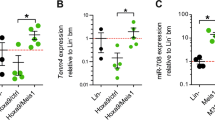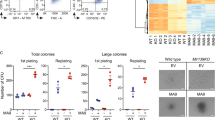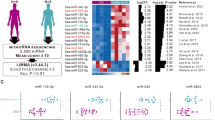Abstract
MicroRNAs have been shown to play an important role in normal hematopoisis and leukemogenesis. Here, we report function and mechanisms of miR-181 family in myeloid differentiation and acute myeloid leukemia (AML). The aberrant overexpression of all the miR-181 family members (miR-181a/b/c/d) was detected in French–American–British M1, M2 and M3 subtypes of adult AML patients. By conducting gain- and loss-of-function experiments, we demonstrated that miR-181a inhibits granulocytic and macrophage-like differentiation of HL-60 cells and CD34+ hematopoietic stem/progenitor cells (HSPCs) by directly targeting and downregulating the expression of PRKCD (which then affected the PRKCD-P38-C/EBPα pathway), CTDSPL (which then affected the phosphorylation of retinoblastoma protein) and CAMKK1. The three genes were also demonstrated to be the targets of miR-181b, miR-181c and miR-181d, respectively. Significantly decreases in the expression levels of the target proteins were detected in AML patients. Inhibition of the expression of miR-181 family members owing to Lenti-miRZip-181a infection in bone marrow blasts of AML patients increased target protein expression levels and partially reversed myeloid differentiation blockage. In the mice implanted with AML CD34+ HSPCs, expression inhibition of the miR-181 family by Lenti-miRZip-181a injection improved myeloid differentiation, inhibited engraftment and infiltration of the leukemic CD34+ cells into the bone marrow and spleen, and released leukemic symptoms. In conclusion, our findings revealed new mechanism of miR-181 family in normal hematopoiesis and AML development, and suggested that expression inhibition of the miR-181 family could provide a new strategy for AML therapy.
This is a preview of subscription content, access via your institution
Access options
Subscribe to this journal
Receive 50 print issues and online access
$259.00 per year
only $5.18 per issue
Buy this article
- Purchase on Springer Link
- Instant access to full article PDF
Prices may be subject to local taxes which are calculated during checkout








Similar content being viewed by others
References
Rosenbauer F, Tenen DG . Transcription factors in myeloid development: balancing differentiation with transformation. Nat Rev Immunol 2007; 7: 105–117.
Egeland T, Steen R, Quarsten H, Gaudernack G, Yang YC, Thorsby E . Myeloid differentiation of purified CD34+ cells after stimulation with recombinant human granulocyte-monocyte colony-stimulating factor (CSF), granulocyte-CSF, monocyte-CSF, and interleukin-3. Blood 1991; 78: 3192–3199.
Chen CZ, Li L, Lodish HF, Bartel DP . MicroRNAs modulate hematopoietic lineage differentiation. Science 2004; 303: 83–86.
Bennett JM, Catovsky D, Daniel MT, Flandrin G, Galton DA, Gralnick HR et al. Proposed revised criteria for the classification of acute myeloid leukemia. A report of the French-American-British Cooperative Group. Ann Intern Med 1985; 103: 620–625.
Charrad RS, Li Y, Delpech B, Balitrand N, Clay D, Jasmin C et al. Ligation of the CD44 adhesion molecule reverses blockage of differentiation in human acute myeloid leukemia. Nat Med 1999; 5: 669–676.
Garzon R, Volinia S, Liu CG, Fernandez-Cymering C, Palumbo T, Pichiorri F et al. MicroRNA signatures associated with cytogenetics and prognosis in acute myeloid leukemia. Blood 2008; 111: 3183–3189.
Lim LP, Lau NC, Garrett-Engele P, Grimson A, Schelter JM, Castle J et al. Microarray analysis shows that some microRNAs downregulate large numbers of target mRNAs. Nature 2005; 433: 769–773.
Yendamuri S, Calin GA . The role of microRNA in human leukemia: a review. Leukemia 2009; 23: 1257–1263.
Pulikkan JA, Dengler V, Peramangalam PS, Peer Zada AA, Muller-Tidow C, Bohlander SK et al. Cell-cycle regulator E2F1 and microRNA-223 comprise an autoregulatory negative feedback loop in acute myeloid leukemia. Blood 2010; 115: 1768–1778.
Wang XS, Gong JN, Yu J, Wang F, Zhang XH, Yin XL et al. MicroRNA-29a and microRNA-142-3p are regulators of myeloid differentiation and acute myeloid leukemia. Blood 2012; 119: 4992–5004.
Chen G, Zhu W, Shi D, Lv L, Zhang C, Liu P et al. MicroRNA-181a sensitizes human malignant glioma U87MG cells to radiation by targeting Bcl-2. Oncol Rep 2010; 23: 997–1003.
Ji J, Yamashita T, Budhu A, Forgues M, Jia HL, Li C et al. Identification of microRNA-181 by genome-wide screening as a critical player in EpCAM-positive hepatic cancer stem cells. Hepatology 2009; 50: 472–480.
Wang B, Hsu SH, Majumder S, Kutay H, Huang W, Jacob ST et al. TGFbeta-mediated upregulation of hepatic miR-181b promotes hepatocarcinogenesis by targeting TIMP3. Oncogene 2010; 29: 1787–1797.
Pons A, Nomdedeu B, Navarro A, Gaya A, Gel B, Diaz T et al. Hematopoiesis-related microRNA expression in myelodysplastic syndromes. Leuk Lymphoma 2009; 50: 1854–1859.
Pichiorri F, Suh SS, Ladetto M, Kuehl M, Palumbo T, Drandi D et al. MicroRNAs regulate critical genes associated with multiple myeloma pathogenesis. Proc Natl Acad Sci USA 2008; 105: 12885–12890.
Bisso A, Faleschini M, Zampa F, Capaci V, De Santa J, Santarpia L et al. Oncogenic miR-181a/b affect the DNA damage response in aggressive breast cancer. Cell Cycle 2013; 12: 1679–1687.
Taylor MA, Sossey-Alaoui K, Thompson CL, Danielpour D, Schiemann WP . TGF-beta upregulates miR-181a expression to promote breast cancer metastasis. J Clin Invest 2013; 123: 150–163.
Debernardi S, Skoulakis S, Molloy G, Chaplin T, Dixon-McIver A, Young BD . MicroRNA miR-181a correlates with morphological sub-class of acute myeloid leukaemia and the expression of its target genes in global genome-wide analysis. Leukemia 2007; 21: 912–916.
Careccia S, Mainardi S, Pelosi A, Gurtner A, Diverio D, Riccioni R et al. A restricted signature of miRNAs distinguishes APL blasts from normal promyelocytes. Oncogene 2009; 28: 4034–4040.
Garzon R, Pichiorri F, Palumbo T, Visentini M, Aqeilan R, Cimmino A et al. MicroRNA gene expression during retinoic acid-induced differentiation of human acute promyelocytic leukemia. Oncogene 2007; 26: 4148–4157.
Wang X, Gocek E, Liu CG, Studzinski GP . MicroRNAs181 regulate the expression of p27Kip1 in human myeloid leukemia cells induced to differentiate by 1,25-dihydroxyvitamin D3. Cell Cycle 2009; 8: 736–741.
Georgantas RW 3rd, Hildreth R, Morisot S, Alder J, Liu CG, Heimfeld S et al. CD34+ hematopoietic stem-progenitor cell microRNA expression and function: a circuit diagram of differentiation control. Proc Natl Acad Sci USA 2007; 104: 2750–2755.
Kikkawa U, Matsuzaki H, Yamamoto T . Protein kinase C delta (PKC delta): activation mechanisms and functions. J Biochem 2002; 132: 831–839.
Kambhampati S, Li Y, Verma A, Sassano A, Majchrzak B, Deb DK et al. Activation of protein kinase C delta by all-trans-retinoic acid. J Biol Chem 2003; 278: 32544–32551.
Nitti M, Furfaro AL, Cevasco C, Traverso N, Marinari UM, Pronzato MA et al. PKC delta and NADPH oxidase in retinoic acid-induced neuroblastoma cell differentiation. Cell Signal 2010; 22: 828–835.
Gan X, Wang J, Wang C, Sommer E, Kozasa T, Srinivasula S et al. PRR5L degradation promotes mTORC2-mediated PKC-delta phosphorylation and cell migration downstream of Galpha12. Nat Cell Biol 2012; 14: 686–696.
Zhao KW, Li X, Zhao Q, Huang Y, Li D, Peng ZG et al. Protein kinase Cdelta mediates retinoic acid and phorbol myristate acetate-induced phospholipid scramblase 1 gene expression: its role in leukemic cell differentiation. Blood 2004; 104: 3731–3738.
Chen C, Du J, Feng W, Song Y, Lu Z, Xu M et al. beta-Adrenergic receptors stimulate interleukin-6 production through Epac-dependent activation of PKCdelta/p38 MAPK signalling in neonatal mouse cardiac fibroblasts. Br J Pharmacol 2012; 166: 676–688.
Ono K, Han J . The p38 signal transduction pathway: activation and function. Cell Signal 2000; 12: 1–13.
Kashuba VI, Li J, Wang F, Senchenko VN, Protopopov A, Malyukova A et al. RBSP3 (HYA22) is a tumor suppressor gene implicated in major epithelial malignancies. Proc Natl Acad Sci USA 2004; 101: 4906–4911.
Dick FA, Dyson N . pRB contains an E2F1-specific binding domain that allows E2F1-induced apoptosis to be regulated separately from other E2F activities. Mol Cell 2003; 12: 639–649.
Li QJ, Chau J, Ebert PJ, Sylvester G, Min H, Liu G et al. miR-181a is an intrinsic modulator of T cell sensitivity and selection. Cell 2007; 129: 147–161.
Fragoso R, Mao T, Wang S, Schaffert S, Gong X, Yue S et al. Modulating the strength and threshold of NOTCH oncogenic signals by mir-181a-1/b-1. PLoS Genet 2012; 8: e1002855.
Li Z, Huang H, Li Y, Jiang X, Chen P, Arnovitz S et al. Up-regulation of a HOXA-PBX3 homeobox-gene signature following down-regulation of miR-181 is associated with adverse prognosis in patients with cytogenetically abnormal AML. Blood 2012; 119: 2314–2324.
Cuesta R, Martinez-Sanchez A, Gebauer F . miR-181a regulates cap-dependent translation of p27(kip1) mRNA in myeloid cells. Mol Cell Biol 2009; 29: 2841–2851.
Ke G, Liang L, Yang JM, Huang X, Han D, Huang S et al. MiR-181a confers resistance of cervical cancer to radiation therapy through targeting the pro-apoptotic PRKCD gene. Oncogene 2013; 32: 3019–3027.
Hampson P, Chahal H, Khanim F, Hayden R, Mulder A, Assi LK et al. PEP005, a selective small-molecule activator of protein kinase C, has potent antileukemic activity mediated via the delta isoform of PKC. Blood 2005; 106: 1362–1368.
Feng W, Song Y, Chen C, Lu ZZ, Zhang Y . Stimulation of adenosine A(2B) receptors induces interleukin-6 secretion in cardiac fibroblasts via the PKC-delta-P38 signalling pathway. Br J Pharmacol 2010; 159: 1598–1607.
Rahman A, Anwar KN, Uddin S, Xu N, Ye RD, Platanias LC et al. Protein kinase C-delta regulates thrombin-induced ICAM-1 gene expression in endothelial cells via activation of p38 mitogen-activated protein kinase. Mol Cell Biol 2001; 21: 5554–5565.
Studzinski GP, Wang X, Ji Y, Wang Q, Zhang Y, Kutner A et al. The rationale for deltanoids in therapy for myeloid leukemia: role of KSR-MAPK-C/EBP pathway. J Steroid Biochem Mol Biol 2005; 97: 47–55.
Senchenko VN, Anedchenko EA, Kondratieva TT, Krasnov GS, Dmitriev AA, Zabarovska VI et al. Simultaneous down-regulation of tumor suppressor genes RBSP3/CTDSPL, NPRL2/G21 and RASSF1A in primary non-small cell lung cancer. BMC Cancer 2010; 10: 75.
Zheng YS, Zhang H, Zhang XJ, Feng DD, Luo XQ, Zeng CW et al. MiR-100 regulates cell differentiation and survival by targeting RBSP3, a phosphatase-like tumor suppressor in acute myeloid leukemia. Oncogene 2012; 31: 80–92.
Soderling TR . The Ca-calmodulin-dependent protein kinase cascade. Trends Biochem Sci 1999; 24: 232–236.
Verploegen S, Ulfman L, van Deutekom HW, van Aalst C, Honing H, Lammers JW et al. Characterization of the role of CaMKI-like kinase (CKLiK) in human granulocyte function. Blood 2005; 106: 1076–1083.
Lawson ND, Zain M, Zibello T, Picciotto MR, Nairn AC, Berliner N . Modulation of a calcium/calmodulin-dependent protein kinase cascade by retinoic acid during neutrophil maturation. Exp Hematol 1999; 27: 1682–1690.
Guest CB, Deszo EL, Hartman ME, York JM, Kelley KW, Freund GG . Ca2+/calmodulin-dependent kinase kinase alpha is expressed by monocytic cells and regulates the activation profile. PLoS ONE 2008; 3: e1606.
Naguibneva I, Ameyar-Zazoua M, Polesskaya A, Ait-Si-Ali S, Groisman R, Souidi M et al. The microRNA miR-181 targets the homeobox protein Hox-A11 during mammalian myoblast differentiation. Nat Cell Biol 2006; 8: 278–284.
Ouyang YB, Lu Y, Yue S, Giffard RG . miR-181 targets multiple Bcl-2 family members and influences apoptosis and mitochondrial function in astrocytes. Mitochondrion 2012; 12: 213–219.
Schwind S, Maharry K, Radmacher MD, Mrozek K, Holland KB, Margeson D et al. Prognostic significance of expression of a single microRNA, miR-181a, in cytogenetically normal acute myeloid leukemia: a Cancer and Leukemia Group B study. J Clin Oncol 2010; 28: 5257–5264.
Marcucci G, Radmacher MD, Maharry K, Mrozek K, Ruppert AS, Paschka P et al. MicroRNA expression in cytogenetically normal acute myeloid leukemia. N Engl J Med 2008; 358: 1919–1928.
Acknowledgements
This work was funded by the National Natural Science Foundation of China grants 31171311 and 30970616 (to J-WZ) and 81070435 (to H-MN).
Author information
Authors and Affiliations
Corresponding author
Ethics declarations
Competing interests
The authors declare no conflict of interest.
Additional information
Supplementary Information accompanies this paper on the Oncogene website
Supplementary information
Rights and permissions
About this article
Cite this article
Su, R., Lin, HS., Zhang, XH. et al. MiR-181 family: regulators of myeloid differentiation and acute myeloid leukemia as well as potential therapeutic targets. Oncogene 34, 3226–3239 (2015). https://doi.org/10.1038/onc.2014.274
Received:
Revised:
Accepted:
Published:
Issue Date:
DOI: https://doi.org/10.1038/onc.2014.274
This article is cited by
-
Oncogenic lncRNA FAM215A promotes the malignant cell phenotypes of acute myeloid leukemia (AML) cell lines
Journal of Molecular Histology (2024)
-
Insight into microRNAs’ involvement in hematopoiesis: current standing point of findings
Stem Cell Research & Therapy (2023)
-
Pinostrobin, a fingerroot compound, regulates miR-181b-5p and induces acute leukemic cell apoptosis
Scientific Reports (2023)
-
The Effects of Resveratrol, Gallic Acid, and Piperine on the Expression of miR-17, miR-92b, miR-181a, miR-222, BAX, BCL-2, MCL-1, WT1, c-Kit, and CEBPA in Human Acute Myeloid Leukemia Cells and Their Roles in Apoptosis
Biochemical Genetics (2023)
-
Bioinformatics Analysis of miR-181a and Its Role in Adipogenesis, Obesity, and Lipid Metabolism Through Review of Literature
Molecular Biotechnology (2023)



